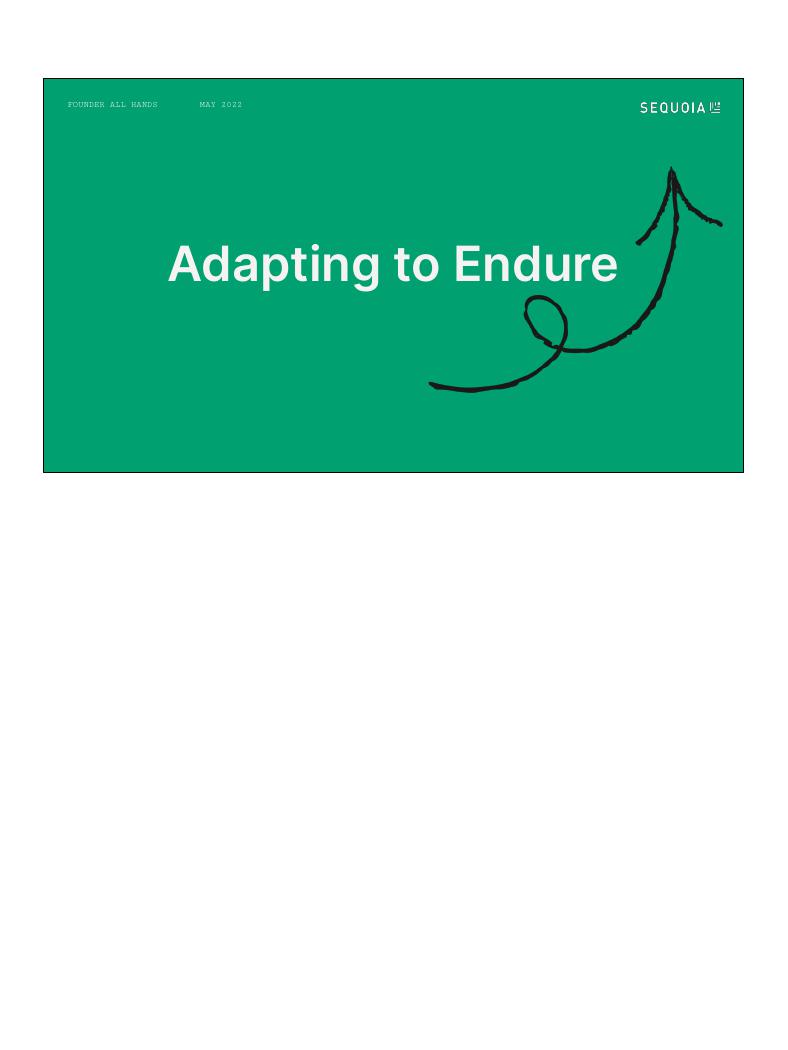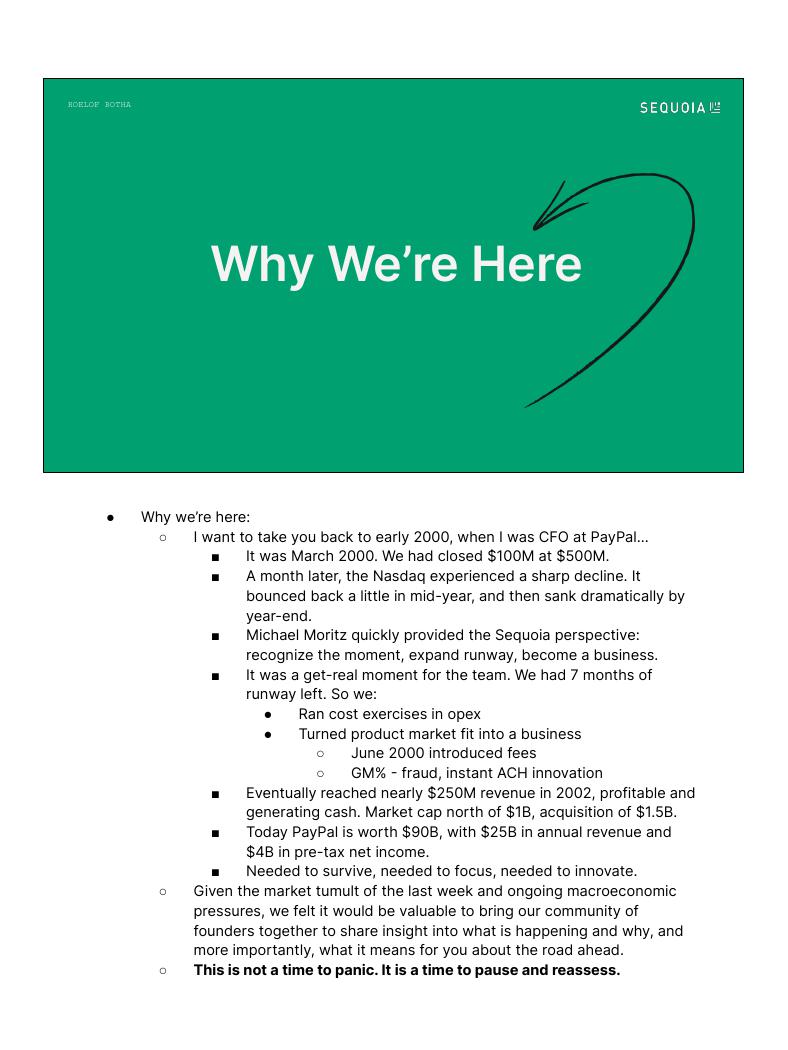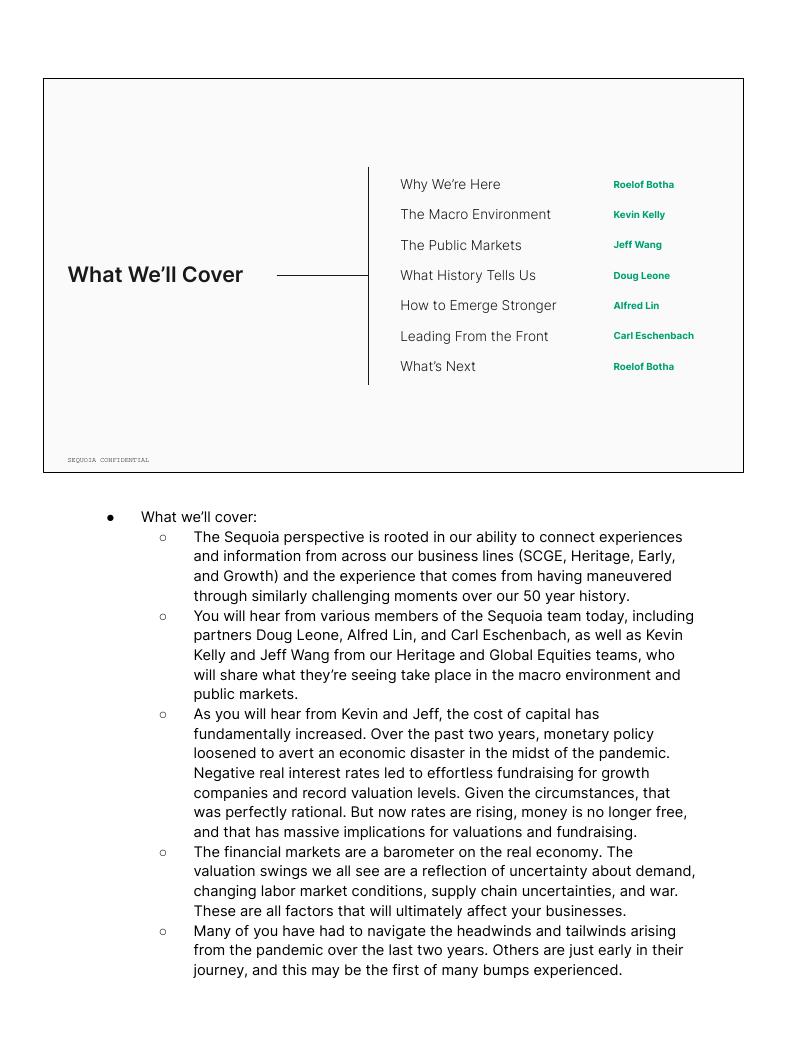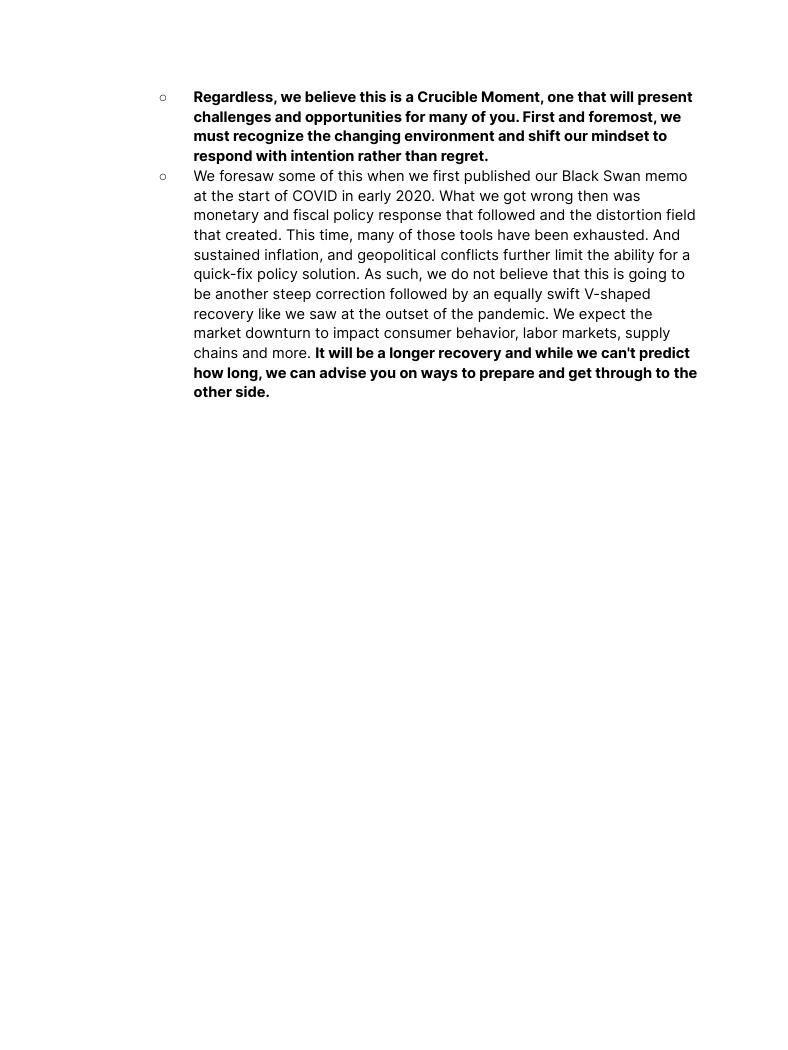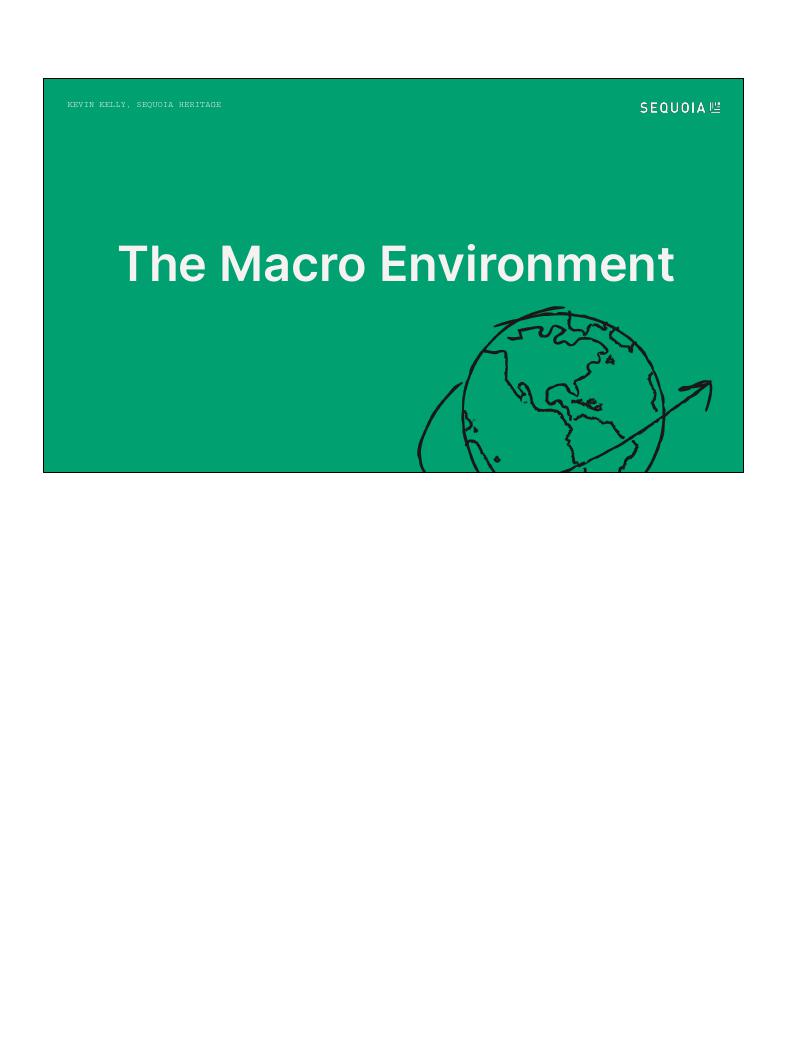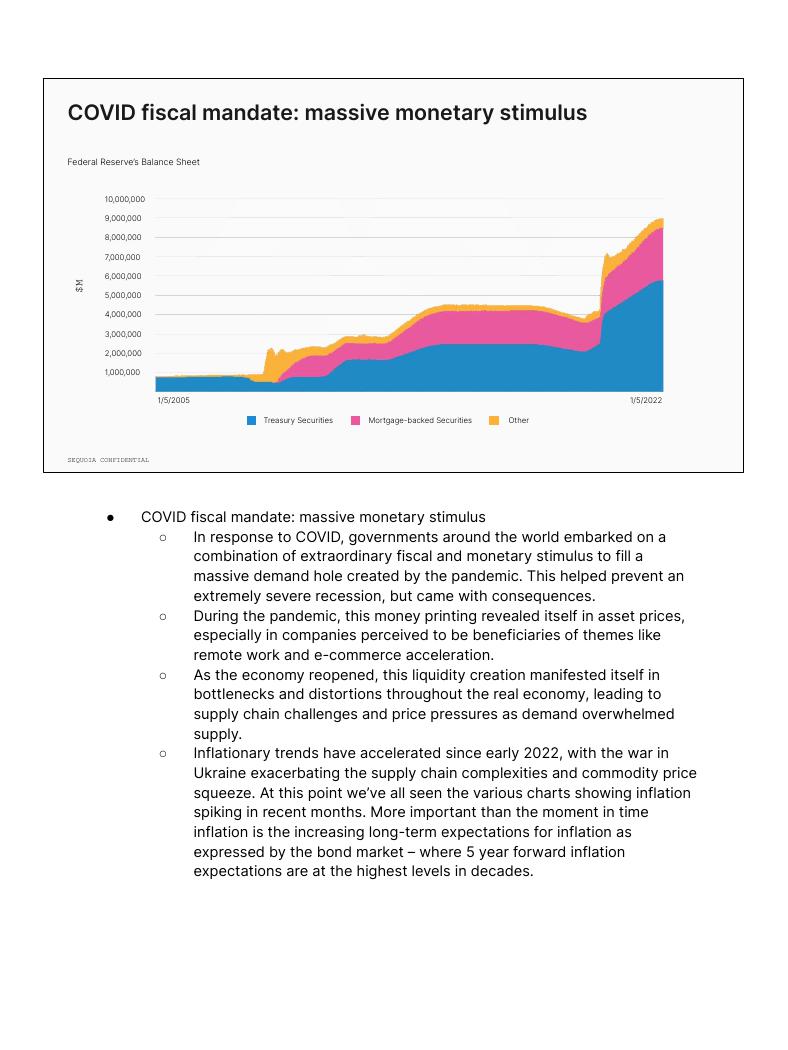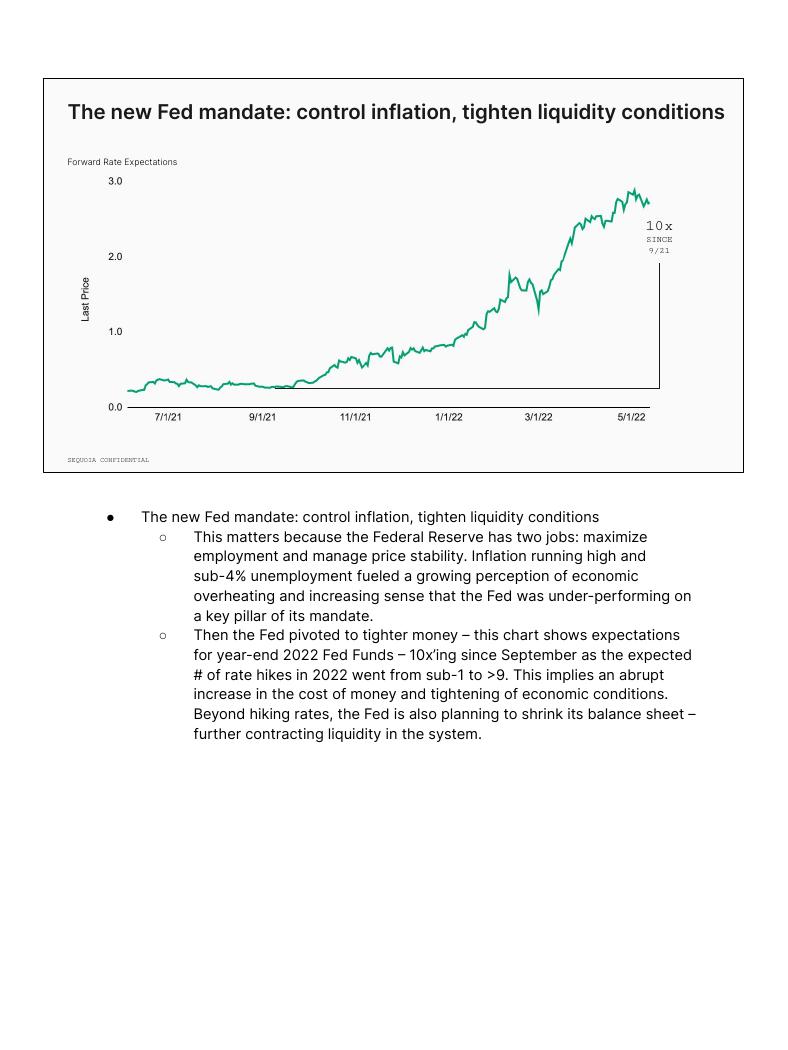FOUNDER ALL HANDS MAY 2022
Adapting to Endure
�
ROELOF BOTHA
Why We’re Here
● Why we’re here:
○
I want to take you back to early 2000, when I was CFO at PayPal…
It was March 2000. We had closed $100M at $500M.
A month later, the Nasdaq experienced a sharp decline. It
bounced back a little in mid-year, and then sank dramatically by
year-end.
Michael Moritz quickly provided the Sequoia perspective:
recognize the moment, expand runway, become a business.
It was a get-real moment for the team. We had 7 months of
runway left. So we:
●
●
Ran cost exercises in opex
Turned product market fit into a business
○
○
June 2000 introduced fees
GM% - fraud, instant ACH innovation
■
■
■
■
■
■
■
Eventually reached nearly $250M revenue in 2002, profitable and
generating cash. Market cap north of $1B, acquisition of $1.5B.
Today PayPal is worth $90B, with $25B in annual revenue and
$4B in pre-tax net income.
Needed to survive, needed to focus, needed to innovate.
○
○
Given the market tumult of the last week and ongoing macroeconomic
pressures, we felt it would be valuable to bring our community of
founders together to share insight into what is happening and why, and
more importantly, what it means for you about the road ahead.
This is not a time to panic. It is a time to pause and reassess.
�
Why We’re Here
The Macro Environment
The Public Markets
What History Tells Us
How to Emerge Stronger
Leading From the Front
What’s Next
Roelof Botha
Kevin Kelly
Jeff Wang
Doug Leone
Alfred Lin
Carl Eschenbach
Roelof Botha
What We’ll Cover
SEQUOIA CONFIDENTIAL
● What we’ll cover:
○
○
○
○
○
The Sequoia perspective is rooted in our ability to connect experiences
and information from across our business lines (SCGE, Heritage, Early,
and Growth) and the experience that comes from having maneuvered
through similarly challenging moments over our 50 year history.
You will hear from various members of the Sequoia team today, including
partners Doug Leone, Alfred Lin, and Carl Eschenbach, as well as Kevin
Kelly and Jeff Wang from our Heritage and Global Equities teams, who
will share what they’re seeing take place in the macro environment and
public markets.
As you will hear from Kevin and Jeff, the cost of capital has
fundamentally increased. Over the past two years, monetary policy
loosened to avert an economic disaster in the midst of the pandemic.
Negative real interest rates led to effortless fundraising for growth
companies and record valuation levels. Given the circumstances, that
was perfectly rational. But now rates are rising, money is no longer free,
and that has massive implications for valuations and fundraising.
The financial markets are a barometer on the real economy. The
valuation swings we all see are a reflection of uncertainty about demand,
changing labor market conditions, supply chain uncertainties, and war.
These are all factors that will ultimately affect your businesses.
Many of you have had to navigate the headwinds and tailwinds arising
from the pandemic over the last two years. Others are just early in their
journey, and this may be the first of many bumps experienced.
�
Regardless, we believe this is a Crucible Moment, one that will present
challenges and opportunities for many of you. First and foremost, we
must recognize the changing environment and shift our mindset to
respond with intention rather than regret.
○ We foresaw some of this when we first published our Black Swan memo
○
at the start of COVID in early 2020. What we got wrong then was
monetary and fiscal policy response that followed and the distortion field
that created. This time, many of those tools have been exhausted. And
sustained inflation, and geopolitical conflicts further limit the ability for a
quick-fix policy solution. As such, we do not believe that this is going to
be another steep correction followed by an equally swift V-shaped
recovery like we saw at the outset of the pandemic. We expect the
market downturn to impact consumer behavior, labor markets, supply
chains and more. It will be a longer recovery and while we can't predict
how long, we can advise you on ways to prepare and get through to the
other side.
�
KEVIN KELLY, SEQUOIA HERITAGE
The Macro Environment
�
COVID fiscal mandate: massive monetary stimulus
Federal Reserve’s Balance Sheet
M
$
10,000,000
9,000,000
8,000,000
7,000,000
6,000,000
5,000,000
4,000,000
3,000,000
2,000,000
1,000,000
SEQUOIA CONFIDENTIAL
1/5/2005
1/5/2022
Treasury Securities
Mortgage-backed Securities
Other
●
COVID fiscal mandate: massive monetary stimulus
○
○
○
○
In response to COVID, governments around the world embarked on a
combination of extraordinary fiscal and monetary stimulus to fill a
massive demand hole created by the pandemic. This helped prevent an
extremely severe recession, but came with consequences.
During the pandemic, this money printing revealed itself in asset prices,
especially in companies perceived to be beneficiaries of themes like
remote work and e-commerce acceleration.
As the economy reopened, this liquidity creation manifested itself in
bottlenecks and distortions throughout the real economy, leading to
supply chain challenges and price pressures as demand overwhelmed
supply.
Inflationary trends have accelerated since early 2022, with the war in
Ukraine exacerbating the supply chain complexities and commodity price
squeeze. At this point we’ve all seen the various charts showing inflation
spiking in recent months. More important than the moment in time
inflation is the increasing long-term expectations for inflation as
expressed by the bond market – where 5 year forward inflation
expectations are at the highest levels in decades.
�
The new Fed mandate: control inflation, tighten liquidity conditions
Forward Rate Expectations
10x
SINCE
9/21
SEQUOIA CONFIDENTIAL
○
○
●
The new Fed mandate: control inflation, tighten liquidity conditions
This matters because the Federal Reserve has two jobs: maximize
employment and manage price stability. Inflation running high and
sub-4% unemployment fueled a growing perception of economic
overheating and increasing sense that the Fed was under-performing on
a key pillar of its mandate.
Then the Fed pivoted to tighter money – this chart shows expectations
for year-end 2022 Fed Funds – 10x’ing since September as the expected
# of rate hikes in 2022 went from sub-1 to >9. This implies an abrupt
increase in the cost of money and tightening of economic conditions.
Beyond hiking rates, the Fed is also planning to shrink its balance sheet –
further contracting liquidity in the system.
�
Capital was free.
Now it’s expensive.
When capital was free, the best performing companies were
capital consumptive.
As capital has gotten expensive, these have become the worst
performing companies.
What are the other implications of capital being expensive?
Given every dollar is more precious than it was, how are you
going to change your priorities?
SEQUOIA CONFIDENTIAL
●
Capital was free. Now it’s expensive.
○
○
As this pivot was digested by the markets, the best performing assets
when rate expectations were falling – including technology,
biotechnology, and recent IPOs – have been the worst performing assets.
Simply put, the world is reassessing how business models fare in a world
where capital has a cost and reconsidering how much credit to give
companies for profits many years into the future. My partner Jeff will
describe this in further detail momentarily.
This would matter less if it was solely about new multiples ascribed to
each dollar of revenue. However, market indicators, including broader
equity prices, high yield spreads, and the yield curve, are beginning to
flash warning signs of further economic deterioration… so it might not
just be a question of valuations resetting.
○ We are just beginning to see how the increasing cost of money flows
through to impact the real economy. To give just one example in the
housing sector. In the last 6 months, due to the changing cost of money,
a new mortgage is 67% more expensive for the same house – the largest
percentage shock in 50 years and putting housing affordability back to
levels last seen at the peak of the housing boom. For this reason, public
markets are already anticipating a severe slowdown in housing activity
with homebuilders down ~30% from their highs.
Undoubtedly, calls like this one are happening across sectors in response
to recent market dynamics. If you’re stepping back and thinking twice,
it’s not just you. Belt tightening and priority reassessment will have
○
�
